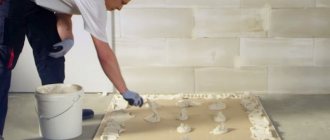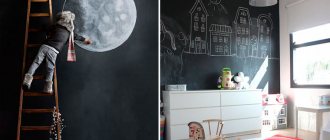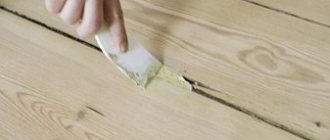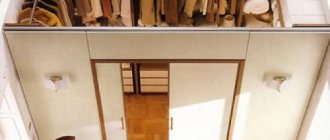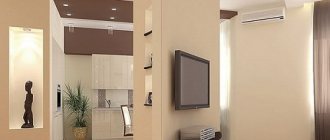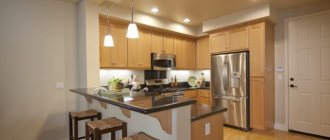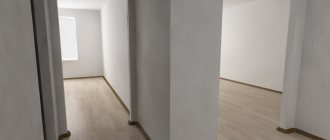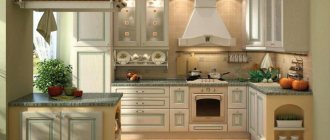Selection of soundproofing material
Different brands of plasterboard sheets have different soundproofing characteristics. The following sheets have maximum protection from extraneous noise:
- Knauf;
- Aku-Line;
- Volma;
- Magma.
The cost of the material is about 700 rubles per sheet.
Acoustic drywall is a sheet with a large number of holes. This design reflects sounds from the surface of the walls.
A soundproofed plasterboard partition is a multi-layer structure, for the installation of which materials with sound-proofing properties are used. This applies not only to drywall and filler, but also to framing and fasteners.
Materials for filling partitions
- Acoustic mats. A slab made of stone wool. The panel has a uniform surface, thanks to which sound waves are reflected from the surface. This material is environmentally friendly and safe.
Fiberglass based boards. The slabs are most in demand on the building materials market because they have a number of advantages:
- not subject to rotting processes;
- resistant to moisture;
- don't burn.
The sound insulation characteristics of the slabs are significantly higher than those of other materials.
Soundproofing material is presented in the form of sheets and rolls, the most popular are mineral, basalt and ecowool, felt.
Elastic materials that are mounted between supporting structures. The main function is to neutralize sounds from impacts.
Panels made of polyester and polyurethane foam. They are used to fill partitions and to install additional walls in the room.
In rare cases, the internal supporting surfaces are additionally glued with a backing made of cork or foil materials. However, in the case of plasterboard partitions, this option is ineffective.
Features of sound insulation of plasterboard partitions:
- The optimal choice is materials based on mineral wool.
- Foam is also used, but it only reduces the noise level and does not absorb it. Compared to other sound-absorbing materials, foam is ineffective.
- Sprayers are used as sound insulation - these are cellulose fibers impregnated with glue. During application to the surface, the thickness of the layer can be adjusted.
General information about the material
The entire surface of acoustic plasterboard is covered with through holes.
A new type of plasterboard sheets appeared not long ago to become popular. This product was invented specifically for use in rooms where there are increased requirements for sound insulation. However, it can be used within your apartment so as not to conflict with neighbors due to excessive noise.
Soundproofing plasterboard obtains its properties thanks to the following technical solutions.
- The presence of perforations over the entire sheet area. The many small holes are what help the sheet absorb sound.
- The back side of the material is made of non-woven fabric, which is also a soundproofing material.
Both of these factors combined helped transform an ordinary sheet of drywall into a true soundproofing material.
Thanks to perforation, many through holes act as resonators. Instead of sound waves bouncing off a flat surface, they enter holes where they are attenuated.
Is it worth installing soundproofing in the ceiling?
A greater effect can be achieved if you make a floating floor in the room located above your head with a layer of insulation placed inside. This option is possible in a private house with a height of more than one floor. It makes sense to soundproof the ceiling in an apartment in compliance with all technology requirements. They will be described below.
How does a sound insulator prevent noise from entering a room? The noise can be impact - a mechanical impact on the ceiling (clattering heels, objects falling on the floor) and airborne (conversations, screams), also falling on obstacles that arise along the way. In this case - walls and floor. As a result, the person below hears noise that spreads along the supporting structures through their structure. Soundproofing material helps to partially absorb it. But it's not enough. It is necessary to lay a sealing tape where the ceiling adjoins the load-bearing foundations.
Requirements for soundproofing materials and ceiling construction:
- During transportation, the material must be reliably protected from moisture;
- Storage is carried out in dry rooms with a standardized level of humidity, in packaged form;
- To create a sound insulation layer, it is recommended to use mineral wool with a thickness of at least 4 cm or extruded polystyrene foam;
- To ensure better noise absorption at the junction of the profiles with the walls and sub-ceiling, it is necessary to lay a sealing tape, which is glued to the base of each profile.
How to increase noise absorption in addition to installing a layer of insulation?
You can “help” mineral wool or other material absorb noise by using some cladding tricks:
- Sheathing with two layers of gypsum board sheets. For a ceiling, such a solution is not always relevant, but it is possible taking into account a careful calculation of the weight of the structure, the thickness of the profiles, and components. One layer of gypsum plasterboard, 12.5 mm thick, increases sound insulation by 4 dts, 2 – by 8 dts;
- Increasing the space between the floor slabs and the new gypsum board base. The bigger it is, the better. The insulation can be laid in 2 layers. This solution is acceptable in rooms with a wall height of more than 2.7 meters;
- Make a ceiling without a strong connection to the wall - on hangers, seal the joints with sealant.
Types of perforation
There are patterns and types of perforations. Knauf panels have 2 perforation patterns:
- Solid (C). The holes are distributed evenly across the plane of the sheet.
- Block (B). The holes are arranged in blocks.
The type of perforation is determined by the size, shape and distance between the holes:
- Round (1) 8/18. The hole diameter is 8 mm, the centers of the holes are equidistant from each other by 18 mm.
- Square (2) 12/25. The side of the square is 12 mm, the distance between centers is 25 mm.
- Scattered round (C3) 8/15/20. The panel has 3 types of holes with a diameter of 8, 15 and 20 mm. They are located chaotically.
Types of perforation
Different combinations of pattern and type of Knauf perforation form 5 types of panel design.
What you will definitely need
Naturally, standard materials are needed to assemble the ceiling base - guides and ceiling profiles marked UD and CD, respectively.
For cladding, you can use ordinary plasterboard or moisture-resistant plasterboard, depending on the room where such a ceiling will be assembled. To assemble a complete soundproofing system, other materials are required.
- Firstly, you need high-quality sound-absorbing fillers for plasterboard sheathing. Most often, mineral wool slabs (can be of different thicknesses), polystyrene foam (polyurethane foam), various natural materials - peat, coconut shavings, cork, sound-absorbing synthetic membranes are used for these purposes.
- Secondly, do not forget that the frame itself, on which the casing will be attached, has the ability to vibrate due to vibrations, which means it is necessary to level out this factor. For this, insulating tape is used, which is mounted around the perimeter of the base, serving as a damper between the guide profiles and the load-bearing walls of the building. An important element of the soundproofing frame of a plasterboard suspended ceiling are vibration suspensions.
A special feature of vibration suspensions is the presence of a noise-absorbing element, which dampens vibrations transmitted from the walls and ceiling.
The most common option for a soundproofing ceiling is when sound insulation is provided by a filler made of mineral wool or polystyrene foam.
Mineral wool has many advantages. In addition to its thermal insulating properties, it can absorb up to 70% of noise vibrations. The only drawback of using such an insulator is that it “eats up” the space under the plasterboard sheathing, which makes it difficult to install spotlights. Polyurethane foam or polystyrene foam also dampens vibrations quite well, especially sounds such as steps, falling objects, and movement on the floor in the apartment from above. The only point in which the material is inferior to mineral wool is fire safety.
An example of laying soundproofing foam into a ceiling frame. It is also advisable to use a special sound-absorbing membrane for lining the filler. It is mounted on the ceiling before assembling the frame on the ceiling. And only then, for example, mineral wool slabs are laid on it.
It is not very convenient to use cotton wool in rolls; in any case, it will have to be cut into separate pieces in order to be placed in the frame of a suspended ceiling.
Otherwise, the materials and tools are the same as when assembling a conventional suspended ceiling. The assembly technology will differ only slightly with additions regarding the arrangement of the structure with noise-absorbing elements.
Briefly about the advantages of bulkheads made of plasterboard sheets
Gypsum plasterboard sheets are deservedly in demand along with tongue-and-groove slabs when arranging housing. Bulkheads assembled from gypsum plasterboard have proven their positive qualities:
Affordable cost of system components. Light weight of the structure, which is important for apartment buildings. Simple installation and quick construction of walls. Environmental safety and durability.
If necessary, it is possible to use moisture or fire resistant sheets. Modern soundproofing materials based on fiberglass or mineral wool also comply with all environmental and fire safety standards.
What not to do
In the absence of experience, mistakes can be made that can significantly damage the sound insulation of gypsum plasterboard walls. The first mistake is inappropriate materials, for example, polyurethane foam. It is not intended for soundproofing equipment and also does not meet fire safety standards. Polystyrene foam is also not very suitable for creating a noise-absorbing layer. This material is an excellent heat insulator and is intended primarily for insulating the walls of the facade of a building.
The process of soundproofing a wall with foam plastic
Exactly from the street side. Using expanded polystyrene inside an apartment or house can provoke a transfer of the dew point inside under the plasterboard sheathing, as a result the formation of mold is possible, since water vapor will condense in this place.
Soundproofing walls with polystyrene foam
Rolled materials, membranes or mineral wool are installed only overlapping; they should not form gaps at the joints between the individual panels.
If your financial situation does not allow you to completely soundproof your home yourself, you should not save or replace materials. It is better to arrange one room, for example a bedroom, for a more comfortable pastime. Using these recommendations, it’s quite easy to create a high-quality soundproofing pie. Which will help reduce noise in an apartment or house.
Which soundproofing material to choose
A plasterboard partition with high-quality sound insulation is a complex complex structure in which one or two insulating layers cannot be used.
You will need the correct choice of the drywall sheets themselves, the filling of the partition, frame materials and even fasteners.
So, the minimum set that will dampen up to 30% of noise includes:
- GKL (GKLV) PC plasterboard with a thickness of 9.5 or 12.5 mm - is arranged in two or three layers with gaps filled with sound-proofing material, with or without an air gap.
- The main soundproofing layer is sheet or roll material located in the spaces of the “pie”. The most widespread are: ecowool, basalt and mineral wool, felt or other substances.
- An additional soundproofing layer is used less frequently and involves gluing the internal supporting surfaces with cork, rubber-cork or foil backing. The backing is not very effective for plasterboard partitions.
- Frame – is a supporting structure, usually made of aluminum profile. Serves for fixing drywall.
Such an approach to soundproofing a partition will not bring the desired effect, even if the structure is made multilayer.
This is explained by the vibrational nature of sound waves, which propagate perfectly over communicating surfaces of high hardness. In this case, their role is played by the sheets themselves, the frame, and frame fastenings. The following measures will help reduce the impact of this chain:
- the use of OSB boards rather than plasterboard as an internal support sheet;
- the use of microporous rubber gaskets between sheet materials and the floor, ceiling, walls;
- gluing frame profiles with soundproofing tape materials;
- replacing the aluminum profile with timber made from durable types of wood, such as beech;
- installation of special soundproof dowels in the walls.
A correctly performed set of these actions will ensure at least 80% noise suppression, which means that voices, music at medium volume and the sound of moving furniture behind the partition will be almost inaudible.
Popular manufacturers of acoustic drywall
The most in demand is sound-absorbing plasterboard with sound insulation Gyprok Aku-line . This material is often used in the construction of partitions. Reinforcing fibers are added to the gypsum mixture to increase the strength of the products. Dimensions 2500 x 1200 x 12.5 mm.
In second place in popularity is the Rigiton brand . Large-format sheets are mounted using a seamless method, using a special durable putty. The products are used for installation in offices and medical institutions; sheets are produced with round and square perforations. Dimensions 3000 x 1200 x 12.5 mm.
Knauf brand products are no less successfully used . They are produced with various perforation options and are installed in concert halls, music centers, and classrooms. Panel dimensions 2500 x 1500 x 12.5 mm. The products are resistant to temperature changes and humidity.
Installation and soundproofing of plasterboard partitions
Protection against the penetration of extraneous sounds into the room during the construction of hollow and frame partitions increases significantly with an increase in the density and mass of the material used for the cladding, in our case it is gypsum board, as well as the sound-absorbing qualities of the layer and the width of the air space between the cladding.
- The construction of a false wall begins with markings on the floor or lower ceiling. Using a plumb line or a laser level (level), the lines are transferred to the ceiling and walls.
- According to the dimensions calculated during marking, the frame elements are cut.
- Guides for the frame of the structure are attached to the ceiling and floor; fastening is done with dowels, which are spaced in increments of no more than 100 cm. The frame is attached to the walls in the same way. To prevent the transfer of sounds and noise to the partition, an elastic strip, for example, polyurethane or cork tape, is laid between the surface of the floors and walls.
we are installing a frame for a future false wall made of gypsum plasterboard.
This popularity is due to the presence of polymer inserts in the suspensions, which dampen sound upon contact between metal parts.
- In the guide starting profiles (ceiling, floor), transverse posts are mounted and secured with self-tapping screws, the pitch is no more than 60 cm. When making single-layer plasterboard sheathing, the thickness of the sheet is 9.5 mm, to reduce the risk of damage to the plasterboard, the pitch between the posts is recommended to be reduced to 400 or 300 mm.
- Above the door openings, as well as at the joints and joints of the gypsum boards, additional frame racks are installed. A prerequisite is that the joints of the sheets are always placed on the profile. To impart the necessary rigidity to the structure, the racks around the door frame are reinforced by installing a wooden block inside the metal profile.
- Over the entire area of the sheet, using self-tapping screws, the sheathing sheet is fastened to the profile, a step of 25 cm. With a multi-layer structure, the fastener step must be increased, but not more than 60 cm, in this case the joints of the plates should be located in a running direction. The minimum permitted proximity of the location of screws to the edge (joint) of the canvas is 10 mm.
- When placing fastening elements (screws, self-tapping screws), it is necessary to ensure that they are screwed into the plasterboard board only at right angles, while penetrating into the metal studs by at least 10 cm.
We fasten the plasterboard sheets to the profile with self-tapping screws
- In order to allow the plasterboard sheet to expand and/or contract freely when humidity or temperature changes, it is recommended to leave technological gaps:
- ceiling and edge of the canvas - 5 mm;
- floor and trim – 10 mm;
- between 2 sheets with a straight edge – 6 mm;
- folded edge of the canvas - without gaps.
As a result, the gaps, depending on the size and location, are puttied or closed with reinforcing mesh and again covered with putty.
- After installation of the sheathing on one side is completed, the necessary communications are carried out in the internal space of the frame and sound insulation is placed between the sheathing posts. If the thickness of the mineral wool or slabs is less than the width of the profile, then its edges are inserted into the grooves of the racks, where they are additionally fixed with liners. When soundproofing plasterboard partitions, sound absorption boards can be glued to the inside of the frame.
- All communications, including electrical wiring, must pass through the gypsum board sheathing only in special elastic sleeves, for example, made of porous polyethylene or a similar material. This is done in order to eliminate the possibility of the formation of through cracks due to pipe displacement due to temperature changes. All pipes passing through the internal space of the false wall must be covered with the selected sound absorber, at least on one side.
- The final stage is the installation of the second side of the false wall.
In this case, the surface of the floating floor will come into contact with the wall structure only through the sound insulation elements. Thanks to this, the floor will not only serve as a kind of barrier from various sounds, but will also not transmit impact noise to adjacent rooms.
Soundproofing of plasterboard partitions
Properly selected material for soundproofing plasterboard partitions is the key to peace and quiet. By protecting against intrusive conversations, music or TV in the next room, it helps maintain nerves and healthy relationships.
A typical modern interior partition is made of a wooden or metal frame covered with plasterboard on both sides. Such a wall does not resist the passage of sound well. If a similar redevelopment has been made in the apartment, then only soundproofing of plasterboard partitions will save you from noise.
Best materials
The most effective material that completely guarantees results does not yet exist and is unlikely to ever be made. There is also no universal, one-size-fits-all guide to follow when making a room barrier.
The effectiveness of activities depends on each stage. The very first is the installation of the frame. Its design will simply ring if you do not take protective measures - insulate the floor and ceiling from it. Without using a damper tape, it is impossible to achieve any significant results. An excellent damper is the proven Vibrostek-M tape.
As for the frame, there is not much to think about what to choose from - either wood or a metal profile. Their indicators are approximately the same, and little depends on the choice in favor of one or the other.
The panels covering the frame play a significant role. Acoustic plasterboard produced by Knauf or similar products from the Aku-Line line manufactured by Giprok can significantly reduce penetrating noise.
A responsible approach to the task requires that the sheets be laid in 2 layers. Just one layer does not give a quality result. Acoustic triplex, a specialized three-layer material for sound insulation, can also be used as sound insulation under drywall.
A good triplex is produced under the SOUNDLINE-dB brand.
The main role is played by the layer of aggregate laid between the panels. Sound-absorbing boards SCHUMANET-ECO have good performance and suitability for domestic use in apartments.
If the partition has already been built, there is not much to choose from. But it is not necessary to disassemble it and rebuild it. Sound absorption can be significantly improved by using wall membranes. Thanks to them, the volume of reflected sounds directed at the surface of the walls is reduced.
The process of installing sound insulation in a plasterboard partition
A good result depends not only on the materials, but also on how correctly and responsibly the sound insulation is done. Here we can highlight the following, most significant stages:
- Soundproofing a plasterboard wall in an apartment begins with mounting its frame on vibrating tape. It is laid in two layers, attached to the walls, floor and to each other with vibration sealant;
- Frame installation. It is advisable not to place sockets and switches on the future wall - sounds are transmitted very well through them. A rational solution would be to make the distances between the profiles correspond to the size of the soundproofing slab;
- Installation of plasterboard sheets of partitions on one side. Acoustic plasterboard is installed with perforations facing outwards;
- Laying sound-absorbing slabs in the interior partition. Their thickness determines what the thickness of the interior partitions will be;
- The final stage is when the slabs are covered with gypsum boards. To do everything correctly here, the joints need to be sealed with vibration sealant.
Soundproofing technology for plasterboard walls
Soundproofing of interior plasterboard partitions should not be incredibly thick. Of course, sound transmission depends on the thickness of the enclosing structure, but you should not go to extremes. The best way would be not only to install partitions, but also to improve window openings and use double-glazed windows with high-quality sealing of window joints and cracks. It will not be superfluous to sheath the capital (main) walls on the outside of the building. This, of course, will not be cheap, and you will also need to contact your housing and communal services to obtain permission.
Soundproofing plasterboard partitions alone will be practically useless if the ceilings and floors of the living space also provide excellent sound transmission. Therefore, additional work should be done to soundproof these parts of the building.
Let's imagine that you have already solved the problems with sound insulation of the ceiling and floor. Let us dwell on the issue of insulating the partitions of a structure and determine which building materials are best to use.
To carry out high-quality wall coverings, the most effective way is to use special plasterboard acoustic sheets. This perforated drywall is characterized by a large number of holes and a soundproof non-woven fabric glued to the back of the sheet, thanks to which maximum sound wave damping occurs.
Acoustic plasterboard can be used like traditional plasterboard and finishing work can be carried out on it. The most popular manufacturers of perforated plasterboard sheets are Gyptone and KNAUF. But without a filler, the desired effect may not be achieved.
Return to content
What are the advantages of the material and are there any disadvantages?
Gypsum fiber sheets, like other materials, have their advantages and disadvantages. The main disadvantage of GVL slabs is its cost. This material is currently somewhat more expensive than materials such as plasterboard, plywood, chipboard and MDF boards. Also among the disadvantages of the canvas is its significant weight
When making a frame, it is important to correctly calculate the strength indicator, since the mass of the slabs is considerable. As for the minuses, that’s probably all
Gypsum fiber has many advantages, which is why this material is often used in modern construction. Thanks to the hypoallergenic qualities of the finish, it can be used for residential premises and in particular children's rooms. The microporous structure of gypsum fiber sheets allows the walls to breathe, which helps protect the surface from fungal growth and mold.
Due to the hygroscopicity of the composition, the canvas can independently regulate the humidity of the apartment. If the apartment has high humidity, then the surface of the gypsum fiber board absorbs it. In case of increased levels of dryness, gypsum fiber releases moisture to create optimal climatic conditions. It is also worth mentioning the possibility of using GVL panels in rooms with temperature changes. Gypsum fiber sheet is an ideal material for finishing rooms without heating.
Features of acoustic drywall
The words “acoustic” and “acoustic” when applied to building materials usually tell us that the material has soundproofing or sound-absorbing properties. For example, acoustic mineral wool, soundproofing panels for walls or rolled soundproofing material in the form of a membrane can reduce the noise level in the room by preventing sounds from outside and from neighboring apartments. But acoustic drywall is not on a par with these materials.
This error has crept into many construction sites and portals and misleads people, but if you open the section about Knauf Acoustics slabs on the official website, you will not see a word about the fact that this is a soundproofing material.
Why then do we need acoustic drywall? This material is used to improve the acoustic characteristics of a room. This means that he:
- reduces the level of background noise occurring in the room itself;
- reduces boominess;
- eliminates the “echo” effect;
- allows you to improve speech perception.
Thus, according to Knauf Acoustics itself, plasterboard allows you to create a comfortable acoustic environment in any room, which is especially important for objects with increased requirements for it:
- in recording studios;
- in music classes, concert and rehearsal halls;
- in cinemas;
- in meeting rooms;
- in classrooms.
The acoustic variety of gypsum boards also has a place in the apartment. It will help solve the problem of booming that is typical in some rooms, and will be appreciated by music lovers, musicians playing at home, as well as home theater owners.
Features of use
Installation of perforated drywall is carried out in almost the same way as in the case of conventional plasterboard. Depending on the situation, a frame is created, which is then covered with sheets.
Due to perforation, the sheets have less weight, which makes them easier to work with. They are also easy to cut to the desired size, but cannot be bent.
Self-tapping screws are screwed into the center between the existing holes
You need to fix the sheets to the frame using the same self-tapping screws. They can be screwed into existing holes, but this method of fastening is considered not very reliable. Therefore, special bushings and even dowels are used. You can follow the standard path and fasten the material by turning the self-tapping screw through the entire thickness of the sheet. In this case, you need to be careful, because the self-tapping screw will have to be inserted between the perforations.
Acoustic plasterboard may not be the most suitable solution for soundproofing inside an apartment, but it is ideal for non-residential premises.
Tips for achieving the best soundproofing results under drywall.
- You should follow the technique of layer-by-layer penetration of noise through layers, and then the sound insulation of plasterboard partitions will pay off. All fasteners and structural elements must be installed with soundproofing gaskets.
- The sound insulation effect will be greater if you mount two separate frames, onto which the sheathing will subsequently be attached.
- Sheathing should be selected taking into account the required absorption coefficient Rw - a conditional characteristic that reflects the relationship between the soundproofing parameters of materials and noise in an apartment or on the street. It is better to choose such a coefficient from 0.8 and above.
- The soft layer material should not be less than 100 mm. As a percentage, it should not be less than 50% of the volume of the soundproofing partition.
- Acoustic mineral wool can be placed between the gypsum board frames to create a damping effect. In this case, the sound insulation coefficient increases by reducing the resonance effect in the partition.
- It is necessary to achieve complete tightness of the structures. Avoid any mechanical deformations, holes and cracks. Caulk the joints using a shock-absorbing mesh. Use silicone sealant in areas where electrical wiring and other communications are carried out. Polyurethane foam is not suitable due to its flammability.
A significant effect of sound insulation of interior walls (approximately 30 dB) can be achieved using sound-absorbing membranes. Such elements are attached to the inside of the structure using glue. Soundproofing under drywall - there is no more ideal and justifiable way to protect against noise.
Features of working with Knauf Acoustics panels
When working with acoustic gypsum boards, you need to remember some important points:
The joints of 4PK panels are puttied without the use of reinforcing tape. The edges are pre-cut with a slight bevel, the panels are mounted with a gap of 3–4 mm. The seams will be filled with Uniflot putty, and the recesses from the screws will be filled with putty. After drying, the seams are puttied with finishing putty and sanded.
- The connection of 4FK panels does not require additional processing, since the joining is carried out using folds.
- Arched structures are made using dry and wet bending methods using plywood templates.
Main characteristics
Now let’s find out why Knauf Acoustics slabs have the above properties.
- Perforation on the surface. Many through holes act as resonators, providing sound absorption. As a result, sound waves quickly attenuate, falling into a kind of trap.
- The non-woven fabric on the back side also has sound-absorbing properties. Depending on the design, you can choose gypsum boards with black or white non-woven fabric.
Acoustic gypsum board "Knauf" has several options for the location and shape of holes, by which the material model is determined:
- With continuous perforation. On this model, the holes are distributed evenly over the entire surface.
- With block perforation. The holes are located on the plane in separate groups.
- With round perforation in the form of holes with a diameter of 0.8 cm.
- With square perforation, where the holes are made in the shape of a square with a side of 1.2 cm.
- With scattered round perforation - the holes on the surface are located in a chaotic manner and have different sizes - 0.8 cm, 1.5 cm and 2 cm.
Technical specifications
If we talk about the characteristics of the plates, it is important to note that the products differ in size from standard products. The width of the acoustic plasterboard canvas varies from 1188 to 1224 millimeters. As for the length, there are products from 1998 to 2448 millimeters. Depending on the required parameters, products of certain characteristics are selected. As for the thickness of the slab, it is standard for all canvases and is 12.5 millimeters. This thickness of the product is quite enough for finishing walls and ceilings. The sound absorption coefficient is between 0.2 and 1.0, which fully meets the requirements of high-quality material.
Photo: Main characteristics of drywall. Author: Timur Bazorkin
It is also worth noting that the weight per square meter of the slab is about nine kilograms, which is somewhat lighter than a standard plasterboard product. Due to the lightness of the material, installation work can be carried out independently, which helps save time during repairs in a house or apartment.
Advice! To make it convenient for one person to work with an acoustic gypsum board, you can use a special holder, which will significantly simplify the installation processes.
Necessary materials
Plasterboard walls are created on the basis of a frame made of metal profiles, but when creating sound insulation with your own hands, this will not be enough.
Diagram of a noise-absorbing device for a plasterboard wall
Other materials will also be required:
- A damper tape must be installed under the guide profiles (for example, soundproofing tape “Dichtung”). It will absorb vibrations transmitted from the wall to the frame. You can also use its analogue, fiberglass spatula tape;
- Another element of the frame when creating soundproof walls will be vibration suspensions. This is a modified type of direct suspensions with a noise-absorbing element. They, like the tape, absorb vibrations transmitted from the wall to the frame;
- As the main sound insulator, you need to choose mineral wool, which has excellent vibration absorption qualities. You can also use felt or cork;
- Additionally, a membrane film can be laid under the frame, which has the ability to reduce the penetration of sounds.
This is what a plastic dowel looks like
. In addition to these materials, it is worth purchasing plastic dowels, which resist vibrations better than metal ones.
And don’t forget about switches and sockets in drywall; they also conduct sound well; they must be insulated with rubber pads in the form of washers.
Do-it-yourself noise insulation
In order to make soundproofing, you need to prepare.
Initially, you need to determine what type of material to use for sound insulation. It depends on the room - temperature changes, humidity. After this, prepare the surface. All cracks and crevices must initially be widened and then plastered using reinforcing tape. After this, the surface is cleaned of dust and primed.
The next step is marking the surface. This is done using plumb lines and levels. Upholstery cord is also used.
Materials
To carry out soundproofing under plasterboard on the walls, you will need the following materials:
- damper tape - it is glued to guide profiles, fixed with self-tapping screws to the wall, floor, ceiling;
- vibration suspensions for rack profiles - dampen vibration and sounds coming from outside;
- for sound insulation, you can choose mineral wool - the best option;
- You also need to use a membrane film.
To create a metal frame, plastic dowels are purchased.
Tools
To install a plasterboard surface on a frame base with sound insulation, you will need the following tools:
- construction knife with a set of blades;
- ruler, pencil, level, meter;
- plane;
- spatulas with different blade sizes;
- screwdriver, drill;
- metal scissors;
- hammer.
If you don't have a power tool, you can rent one.
Progress
The damper tape must be glued to the guide profiles and hangers. After using dowels and nails, fix the metal strips along the marks. At a distance of 40 cm from each other, hangers are attached along the notched lines for the rack profile. Rack profiles are fixed onto them by inserting them into the guides. To create a rigid structure, metal strips cut from the racks are horizontally attached between the racks. Crabs are used to connect the planks.
Next, after creating the metal structure, mineral wool must be laid. To ensure dryness and greater sound insulation, a film is fixed under the cotton wool.
After laying the soundproofing material, you need to run the cables and make the electrical wiring. All electrical wires are hidden in corrugation.
After the work is done, plasterboard sheets are installed.
Decorative finishing
An important condition for the long service life of a plasterboard structure is sealing the joints.
For this, putty and KNAUF tape are used. After the putty has dried, the surface is primed, puttyed with a finishing solution, rubbed and covered with putty again. All subsequent finishing is decorative:
- Painting with water-based paint, water-resistant.
- Finishing the painted surface with molding.
- Wallpapering, liquid wallpaper.
- Decorative plaster.
- Finishing with slabs and ceramic tiles.
Each type of work has certain conditions and its own technology.
